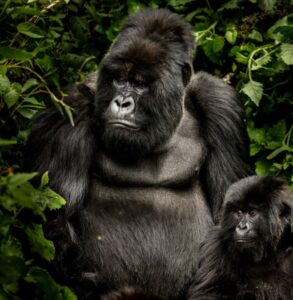What’s the Best Rwandan Dish?
May 3, 2025How to Book Rwanda Gorilla Trekking?
May 4, 2025Why is Volcanoes National Park So Famous?
There are few places on Earth where you can feel the heartbeat of the planet beneath your feet, where smoke kisses the sky and ancient forests whisper stories older than memory. Standing on the edge of a volcanic crater, watching steam rise into the cool morning air at Volcanoes National Park, it’s impossible not to feel a sense of awe. It’s not just a park it’s a living, breathing testament to the raw, magnificent power of nature.
I visited Volcanoes National Park expecting adventure, but what I found was something far more profound: a reconnection with the Earth itself. It’s no wonder this place is famous across the globe. Let me take you through why.
1. Home to Some of the Most Active Volcanoes on Earth
The park is located on the Big Island of Hawaii, and its claim to fame starts with its fiery heart: Kīlauea and Mauna Loa, two of the world’s most active volcanoes. When I visited, Kīlauea had just erupted a few weeks earlier. The black lava rock was still warm underfoot, steam venting from cracks in the earth.
Nowhere else can you safely witness the creation of land in real time. That’s part of the thrill knowing the landscape is always changing. The lava flows that pour from these volcanoes reshape the island continuously, a reminder that nature never stands still.
It’s humbling and exhilarating to realize you’re walking on land younger than you are.
2. A Sacred Place Deeply Rooted in Hawaiian Culture
Volcanoes National Park isn’t just a geological wonder it’s also a deeply spiritual place. Hawaiians believe that Pele, the goddess of fire, lives within the Halemaʻumaʻu Crater at Kīlauea’s summit. And when you’re standing there, it’s not hard to understand why this place is held sacred.
I remember meeting a local park ranger named Keoni. He spoke about Pele not as a myth, but as a real presence. “This land doesn’t belong to us,†he told me. “We are just stewards. She decides what stays and what goes.†That respect for nature and its power permeates everything here.
The park honors these traditions through cultural demonstrations, storytelling, and preserved archaeological sites petroglyphs etched into rock, ancient trails, and sacred sites hidden within the lush forest.
3. A Biodiversity Hotspot Like No Other
What amazed me most wasn’t just the lava, but the life that thrives here. The park stretches from sea level to over 13,000 feet, and that change in elevation means it’s home to multiple ecosystems from tropical rainforests to arid deserts to alpine tundra.
I hiked through Ōhiʻa lehua forests, where bright red blossoms attract rare native birds like the ʻIʻiwi and ʻApapane. These birds are only found in Hawaii and seeing them flit through the trees felt like discovering a hidden treasure.
Some of these species exist nowhere else on Earth. That’s why the park is a UNESCO World Heritage Site its biodiversity is irreplaceable.
4. The Power of Fire and Ice: A Land of Contrasts
The first time I stood near a lava tube the Thurston Lava Tube, to be exact I was struck by how silent it was. Formed by rivers of lava that hollow out underground tunnels, these ancient passageways feel like something from another planet.
Just an hour earlier, I’d watched fog roll over the Crater Rim Drive, where the cool air wrapped around me like a blanket. That’s the surreal magic of Volcanoes National Park it’s a place of fire and ice, of silence and explosions, where opposites co-exist.
At night, the glow from the lava lake in HalemaÊ»umaÊ»u creates a surreal orange halo in the sky. I remember just sitting there in stillness, watching it dance. You don’t need to speak in those moments; the land does all the talking.
5. A Living Laboratory for Scientists and Students
Because it’s one of the most dynamic volcanic landscapes on Earth, the park draws scientists, geologists, and students from around the world. It’s not just a tourist attraction it’s a classroom, a lab, and a storybook of Earth’s history all in one.
I met a geology student who had traveled from Japan just to study the sulfur vents. “There’s no place like this,†she said, sketching in her notebook. “It’s like watching the Earth in mid-sentence, before the paragraph is finished.â€
Researchers here monitor everything from seismic activity to air quality and their findings contribute to global understanding of volcanism and climate science. In a world facing environmental uncertainty, places like Volcanoes National Park are essential.
6. The Trails That Tell a Thousand Stories
Whether you’re an experienced hiker or just looking for a peaceful walk, the park’s trails offer a journey through time and terrain. One of my favorites was the Kīlauea Iki Trail, which takes you across the floor of a crater that erupted in 1959.
There’s something eerie and beautiful about walking across a hardened lava lake, where molten fire once churned. You can feel the history in the cracks beneath your boots.
Every trail here tells a story: of past eruptions, of ancient Hawaiians crossing the land, of rebirth and resilience. There’s something incredibly human about walking through a place shaped by destruction and yet full of life.
7. Accessibility and Sustainability in Action
One of the things that impressed me most was how accessible the park is, without sacrificing its ecological integrity. Visitors with mobility challenges can still enjoy the main lookout points, and the visitor center provides detailed, respectful guidance on how to experience the park without leaving a negative impact.
The park’s commitment to sustainability is visible everywhere from water refill stations to educational signs about staying on trails and respecting native species.
It’s a model of how tourism can coexist with conservation, and as a visitor, it felt good to be part of that mission.
A Place That Changes You
Volcanoes National Park isn’t just famous because it’s beautiful or because it has lava (though that certainly helps). It’s famous because it offers something rare in today’s world: a chance to connect with nature, with culture, with ourselves.
It’s a reminder that the Earth is still alive, still wild, still writing its story. And when you stand at the edge of a crater, breathe in the sulfur-laced air, and feel the rumble beneath your feet, you realize that you’re part of that story too.



